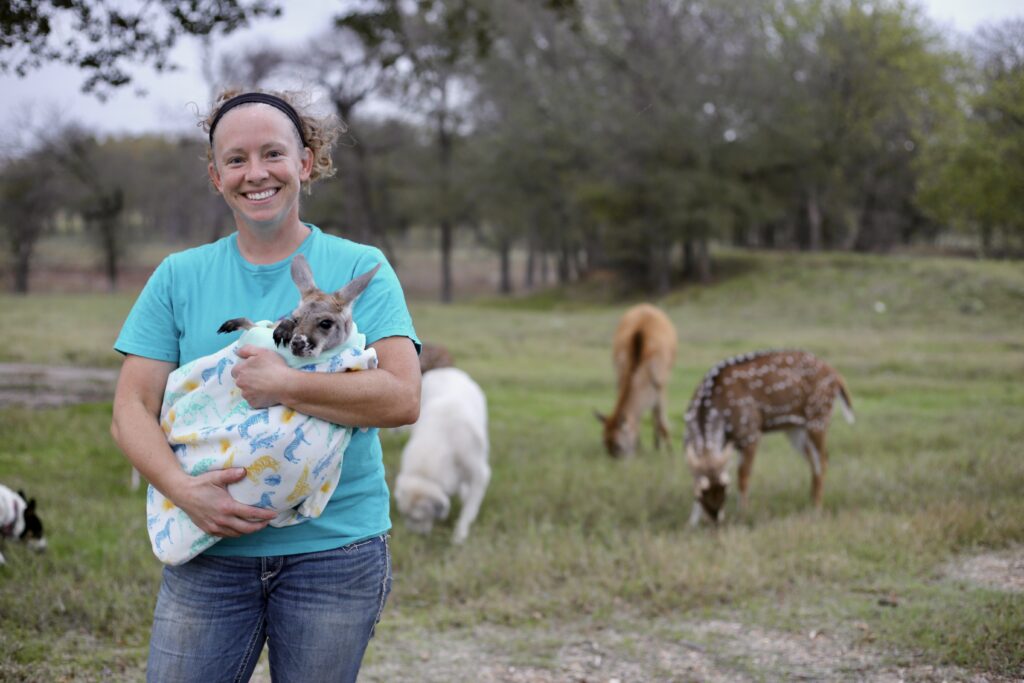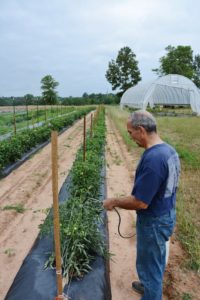Farm & Ranch
[AgriLife Today] Texas crop and weather report for June 20

By: Adam Russell
Summertime vegetable pests emerging
- Writer: Adam Russell, 903-834-6191, [email protected]
- Contact: Dr. Mike Merchant, 972-952-9204, [email protected]
COLLEGE STATION – Pest problems for vegetable producers and gardeners are popping up around the state, according to a Texas A&M AgriLife Extension Service expert.
Dr. Joe Masabni, Texas A&M AgriLife Extension Service horticulturist, sprayed his tomato trial plots with Thuricide to address spider mites, a common summertime pest in vegetables. (Texas A&M AgriLife Extension Service photo by Adam Russell)
Conditions have been good for vegetable production around much of the state following mild spring conditions and ample rains, but the weather is also setting the stage for pests, said Dr. Mike Merchant, AgriLife Extension entomologist, Dallas.
Merchant said it is the time for spider mite emergence in home gardens.
“My personal garden is showing signs of spider mites right now,” he said. “Although I choose to not spray my tomatoes, some gardeners will want to extend the life of their tomatoes with treatments such as insecticidal soap or horticultural oil.”
Merchant said he has not received reports or calls regarding stink bugs but that several varieties, including the Bagrada stink bug, a variety new to Texas and “generalist” feeders that usually prefer vegetables in the cole family can cause problems for vegetables.
“We expect to see Bagrada stink bug become common in mid- to late-summer,” he said.
Merchant said growers and gardeners alike should also be aware of squash vine borers, which lay eggs on plant stems. The emerging caterpillars bore into and hollow out the vines eventually killing the plant.
“The key to squash vine borer control is to treat early, before borers enter the stems and damage shows up,” he said. “Two applications of a labeled insecticide, seven days apart, should help control the newly hatching caterpillars before they enter the stem. Sprays must penetrate the canopy to reach the stems, where the borers lay their eggs.”
Merchant said gardeners with just a few plants may want to go to the trouble of treating vines individually. They can cut the vine or use a syringe to inject Bacillus thuringiensis, a naturally occurring bacteria that controls pests, inside the stem.
Squash bugs represent another tough pest that typically emerges mid-summer as temperatures rise, Merchant said.
“Squash bugs are challenging to control,” he said. “Some of the pyrethroid insecticides can be effective, but users should be aware of the pre-harvest interval on the label, that is how long they must wait before harvest after an application.”
Merchant said home gardeners should learn how to identify squash bug eggs and inspect their plants carefully for eggs, nymphs and adults.
“Then they can use an old-fashioned control technique that nearly always works,” he said. “Squish them.”
AgriLife Extension district reporters compiled the following summaries:
CENTRAL: There was a lot of hay baled during the reporting period. Watermelon and cantaloupe harvests were going full steam, and quality was excellent. Livestock were in good condition and stock tanks were full. Corn looked good. Moderate summer conditions were beneficial for corn and grain sorghum. Some cotton was squaring. Spider mites were in cotton. Farmers sprayed for leafhoppers and were about to spray for spider mites. Most counties reported good soil moisture, and nearly all reported good overall crop, rangeland and pasture conditions. All counties reported good overall livestock conditions.
ROLLING PLAINS: Conditions were hot and windy. Soil moisture declined significantly. Pastures started to lose their green and were becoming more of a fire danger. Dry planted cotton really needed rain. Grass hay was being baled. Livestock were in good condition with some producers beginning to feed hay or supplements, while others were beginning to sell off calves and older cows. Wheat harvests concluded, and producers were preparing fields for next year’s crop.
COASTAL BEND: There was no rainfall and conditions were hot and windy. Soil moisture declined rapidly due to hot, dry weather. Sorghum was starting to color. Corn fields were drying down and corn was in dough stage. Some corn producers were spraying for rust. Cotton looked good and was setting bolls. Rangeland and pastures needed rain. A lot of haymaking was underway. Livestock were doing well with prices holding steady.
EAST: Weather conditions remained good with scattered rains around the district. A break in the rainfall allowed producers to cut and bale hay. Pasture and rangeland conditions were reported as fair to good, with Rusk and Marion counties reporting excellent conditions. Weed control was going well in Upshur County. Some producers in Cherokee County were fighting armyworm infestations. Subsoil and topsoil conditions were mostly adequate. Angelina County reported short conditions, and Shelby County reported surplus conditions. Trinity County reported hard, blowing winds were drying up topsoil moisture. Harvests of vegetables were underway. Anderson County reported good sales on all vegetable crop yields. Field corn was planted in stages due to rain. Reports of corn stages varied from silking to dented. Onions, squash, potatoes and tomatoes were marketed in Smith County. Producers continued to work cattle. Livestock were in fair to good condition. Prices remained stable in Shelby County. Horn fly numbers were on the rise. Wild hog activity increased. Timber harvests in Anderson County picked up now that conditions were drying out.
SOUTH PLAINS: The district experienced high temperatures at or above 100 degrees, including a report of 112 degrees on one day, and peak winds above 32 mph for eight days straight before a cool front lowered temperatures. Only light rainfall amounts fell in most areas, with 0.1 of an inch up to 2 inches in some areas. The moisture was desperately needed. Some counties received hail and lost a couple thousand acres. About half the dryland cotton acres have poor stands or no emergence. Producers were supplementing with irrigation. Early planted irrigated cotton was nearing first square. Corn was nearing tassel. Wheat harvests continued. Pastures and rangelands were in fair to good condition. Cattle were in good condition.
PANHANDLE: Conditions were hot, dry and windy for most of the district. Temperatures were average to above average in most areas including triple digits and record highs. Soil moisture was declining with the high temperatures and windy conditions. Moisture was needed throughout the district. Grasslands were drying quickly with the heat and wind. Deaf Smith County producers were busy harvesting wheat fields and running irrigation on corn and cotton. The wheat crop was coming out quickly with reports of average to a little above average yields on some irrigated wheat. There was one report of wheat yields “way above average.” Corn fields were coming along with most of it being watered as fast as possible. Most cotton looked good. Irrigated cotton was doing well, but dryland cotton needed moisture. Rains and storms came through Hall County and provided much needed moisture, but hail and high winds caused damage to fields. The moisture will be good for pasture and cattle conditions there. Sorghum was being planted behind harvested wheat.
NORTH: Topsoil and subsoil moisture levels ranged from mostly adequate to short with a few counties reporting surplus. The weather was very dry with little to no rain. Temperatures reached the upper 90s in most areas. High winds and high humidity allowed wheat farmers to continue harvesting their winter grasses. Summer grasses and hay were in excellent condition. Spraying continued on harvested hay pastures. Corn, soybeans, grain sorghum and cotton appeared to be doing very well. Livestock pastures looked good. Disease pressure was high on tomatoes and watermelons. Spring-born calves looked nice, and the cattle market was strong.
FAR WEST: Temperatures ranged from 70 at night to 117 degrees in the daytime. Strong winds caused some large tree limbs to fall and dried out what little topsoil moisture there was. Dry conditions and high winds also caused a sand storm. Most cotton emerged except for the last fields planted and it was questionable whether those fields would emerge. Irrigated cotton was holding up but pumps were running hard. Sorghum was starting to show heat stress but still recovering at night. Corn was tasseling, and the heat was not good for pollination. Pastures needed a good rain. Rain reports ranged from 0.25 of an inch to 1 inch. Pea- to quarter-size hail was reported in some areas. Supplemental feeding of livestock and wildlife continued. Late working of lambs and goats continued.
WEST CENTRAL: Conditions were hot, dry and windy. A few areas reported scattered rain showers. Many areas experienced triple-digit temperatures. Good soil moisture was not expected to last long with high temperatures and winds. A few areas continued to finish wheat harvests, and producers were planting cotton as quickly as possible behind harvest. Plowing was underway in some fields after grain harvests were completed. Grain sorghum was in good condition in areas that received rainfall. Sorghum looked poor in other areas that needed rain. Hay and forage crops were in good condition. Many farmers started cutting and baling Coastal Bermuda for hay. Rangeland and pasture conditions remained good and were improving due to recent rainfall. Very hot, dry conditions were forecast and weather likely will have an adverse effect on pasture and crop conditions. Temperatures were expected to be in the triple digits in most areas. Quail call counts were up from 2016. Wildlife managers were expecting a healthy population. Livestock remained in fair to good condition. Cattle prices were down a little on all classes of cattle.
SOUTHEAST: Temperatures were hot, with highs mostly in the 90s. Rice was planted in Chambers County. Livestock were in good condition, but pastures were drying. Areas that received rain reported 1-2 inches or more. Most fields in Brazos County were extremely wet. Fertilized fields were in good shape. Many fields were harvested for hay in the last 10 days. Soil moisture levels throughout the district were adequate to surplus with mostly adequate ratings.
SOUTHWEST: Hot, dry weather reduced soil moisture levels. Hay was made while corn and sorghum were looking good so far. Rangelands and pastures were starting to show some heat stress. There was no rain in the forecast. Livestock were still in good condition.
SOUTH: Temperatures continued to rise throughout the district. Highs were in the upper 90s with reports over 105 degrees. No rainfall was reported. Rangeland and pastures were showing signs of stress, but crop production benefited from the hot, dry weather. Potato and sweet corn harvests continued and should be completed by the next reporting period. Corn was maturing and sorghum was turning color. Cotton was moving from the squaring stage to the boll-setting stage. Peanut planting in Frio County was completed. Fire danger increased because of very dry forage. Some roadside spot fires occurred. Most pastures remained very green from rains that occurred during the previous reporting period. Forage also remained in abundance in those areas, and wildlife habitat was also in good condition for deer, quail, dove and turkey. Body condition scores on cattle remained fair. The live cattle market dropped a small percentage in Brooks County. Crops were being irrigated by using both the Quemado and El Indio canal systems. Watermelon and cantaloupe crops were doing well. Pecans also progressed well. Hay baling and buffel grass seed harvest operations were active, and preparations for row crop harvests continued.
-30-
Find more stories, photos, videos and audio at http://today.agrilife.org
Farm & Ranch
Managing Show Cattle Through The Winter

By Heather Welper
Husband and wife duo, Heather and Calvin Welper, are the Co-Owners and Operators or Two C Livestock, located in Valley View, Texas.
The pair’s operation has a show cattle focus where they raise and sell purebred heifers of all breeds and club calf Hereford steers.
When it comes to show cattle, the Welpers know a thing or two including how to prepare for the cold winter months and the Texas major show season run.
To read more, pick up a copy of the November edition of North Texas Farm & Ranch magazine, available digitally and in print. To subscribe by mail, call 940-872-5922.

Farm & Ranch
Double M Ranch & Rescue

By Hannah Claxton, Editor
As the sun rises each day, so do the dozens of mouths that Meghan McGovern is responsible for getting fed. Rather than the sounds of a rooster crowing, McGovern hears the bellows and bleats of a variety of exotic deer, the chortle of kangaroos, the grunts of water buffaloes, and the chirps of a lemur.
Nestled against the banks of the Red River, the Double M Ranch and Rescue, with its high game fences and deer sprinkling the landscape,s its in stark contrast to the surrounding ranches.
“Having deer is kind of like eating potato chips- you can never actually have just one,” said McGovern with a laugh.
McGovern has several herds to take care of- fallow deer, axis deer, water buffalo, goats, and bison. In smaller numbers, there’s also a few kangaroos, a lemur, a potbelly pig, a pair of zebras, a watusi, and a few horses.
To read more, pick up a copy of the November edition of North Texas Farm & Ranch magazine, available digitally and in print. To subscribe by mail, call 940-872-5922.

Farm & Ranch
Acorn Toxicity

By Barry Whitworth, DVM, MPH
With the prolonged drought, most pastures in Oklahoma end up in poor condition. With the lack of available forage, animals may go in search of alternative foods.
If oak trees are in the pastures, acorns may be a favorite meal for some livestock in the fall. This may result in oak poisoning.
Oak leaves, twigs, buds, and acorns may be toxic to some animals when consumed.
To read more, pick up a copy of the November edition of North Texas Farm & Ranch magazine, available digitally and in print. To subscribe by mail, call 940-872-5922.

-

 Country Lifestyles2 years ago
Country Lifestyles2 years agoScott & Stacey Schumacher: A Growth Mindset
-

 Country Lifestyles8 years ago
Country Lifestyles8 years agoStyle Your Profile – What your style cowboy hat says about you and new trends in 2017
-

 HOME8 years ago
HOME8 years agoGrazing North Texas – Wilman Lovegrass
-

 Equine1 year ago
Equine1 year agoThe Will to Win
-

 Country Lifestyles5 years ago
Country Lifestyles5 years agoAmber Crawford, Breakaway Roper
-

 Outdoor10 years ago
Outdoor10 years agoButtercup or Primrose?
-

 Country Lifestyles9 years ago
Country Lifestyles9 years agoJune 2016 Profile – The man behind the mic: Bob Tallman
-

 Country Lifestyles8 years ago
Country Lifestyles8 years agoDecember 2016 Profile, Rusty Riddle – The Riddle Way






